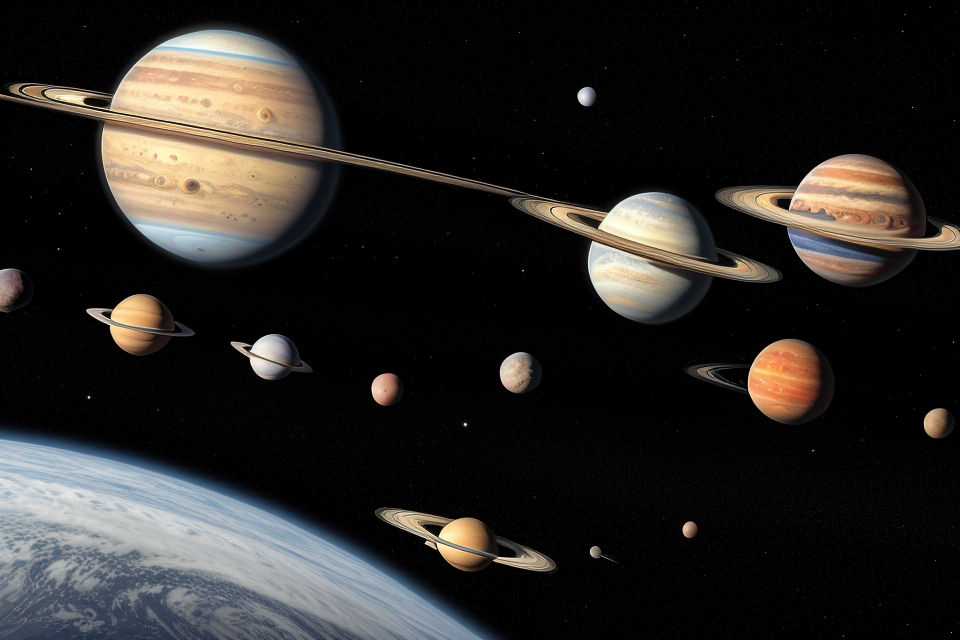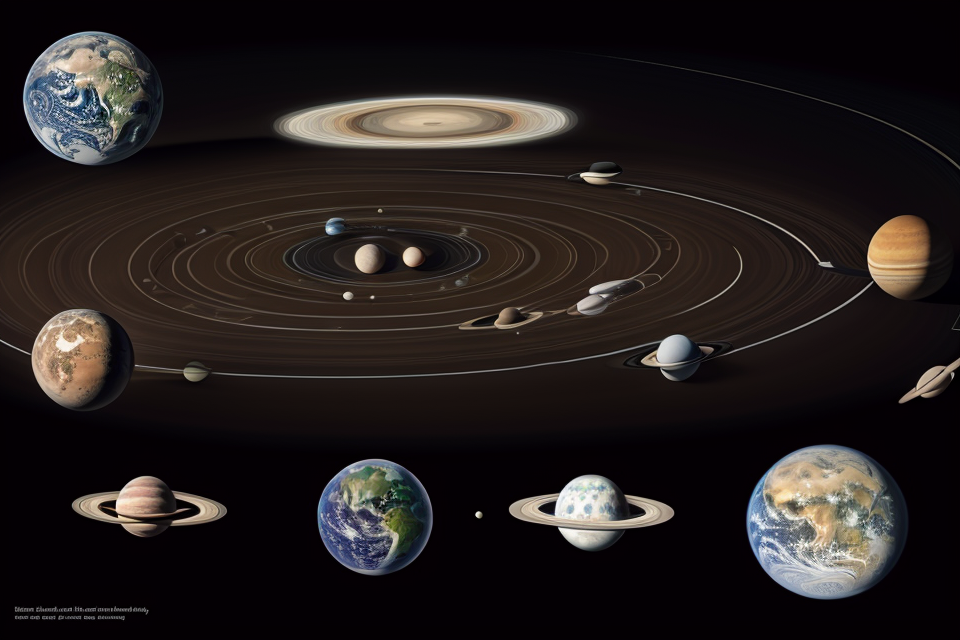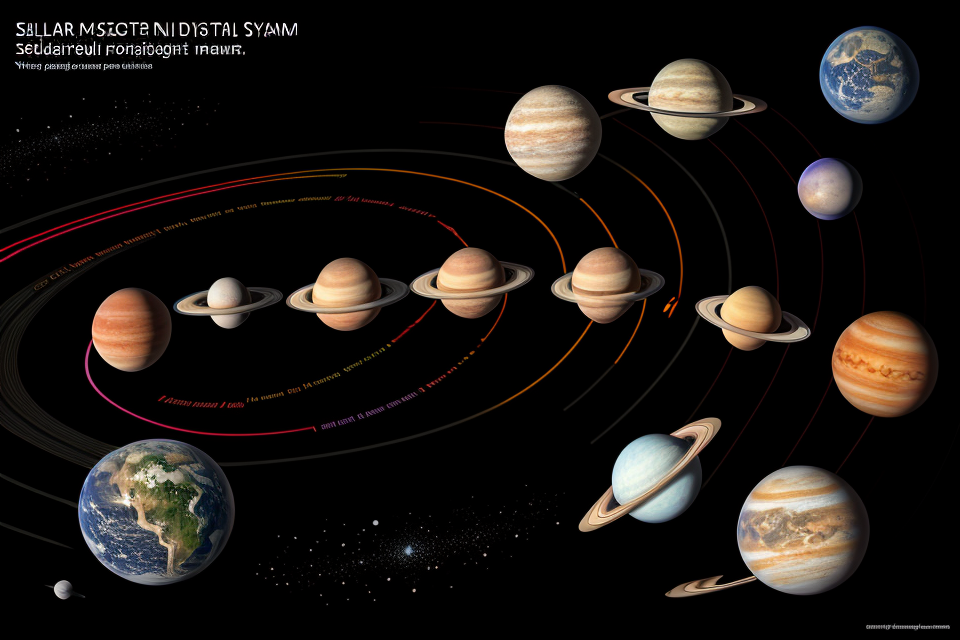The solar system is a wondrous place, filled with celestial bodies that have captivated our imaginations for centuries. One of the most intriguing questions about our solar system is how many planets it contains. Is it just the eight planets that we all learned about in school, or is there something more to discover? In this article, we will delve into the mystery of the planets in our solar system and uncover the truth about how many planets are really out there. Join us as we explore the vast expanse of space and discover the secrets of our solar system.
Exploring the Wonders of Our Solar System
The Sun: The Heart of Our Solar System
- Understanding the Sun’s Importance
- The Sun is the central star of our solar system and is the largest object in the solar system.
- It is composed mostly of hydrogen and helium and is about 93 million miles (150 million kilometers) away from the Earth.
- The Sun’s immense gravitational pull keeps all the planets and other objects in the solar system in orbit around it.
- The Sun’s energy through nuclear fusion provides light and heat to the Earth, making life possible on our planet.
- The Sun’s Role in the Formation of Planets
- The Sun’s immense gravitational pull played a crucial role in the formation of the planets in our solar system.
- The Sun’s gravity drew together a cloud of gas and dust, which eventually formed into the planets.
- The Sun’s heat and light also helped to melt and vaporize some of the materials in the cloud, which later formed into the planets.
- The Sun’s energy and heat continue to influence the planets in our solar system, including the Earth, through its constant radiation and the solar wind.
The Eight Planets: A Closer Look
Mercury: The Smallest Planet in Our Solar System
- Diameter: 3,031 miles
- Average distance from the sun: 36 million miles
- Rotation period: 59 days
- Orbital period: 88 days
- Composition: Rock and metal
- Atmosphere: Thin atmosphere composed mainly of oxygen, sodium, hydrogen, helium, and other gases
- Temperature: -300°F on the surface, but can reach up to 800°F near the equator due to extreme temperature fluctuations caused by its proximity to the sun
- Surface features: Cratered and heavily-irradiated surface, with some evidence of volcanic activity in the past
- Interesting facts: Named after the Roman messenger god, Mercury is the smallest planet in our solar system and orbits the sun faster than any other planet. Its extreme temperature fluctuations are caused by its close proximity to the sun and its lack of a strong magnetic field to protect its atmosphere.
Venus: The Hottest Planet in Our Solar System
- Diameter: 7,521 miles
- Average distance from the sun: 93 million miles
- Rotation period: 243 days
- Orbital period: 225 days
- Atmosphere: Thick, toxic atmosphere composed mainly of carbon dioxide and sulfur dioxide
- Temperature: Surface temperature of 864°F, hot enough to melt lead
- Surface features: Smooth, flat plains, and high volcanic mountains
- Interesting facts: Named after the Roman goddess of love and beauty, Venus is the hottest planet in our solar system due to its thick, toxic atmosphere and close proximity to the sun. Its surface is also completely devoid of water, making it one of the most inhospitable planets in the solar system.
Earth: The Blue Planet and Home to Life
- Diameter: 7,926 miles
- Rotation period: 24 hours
- Orbital period: 365.25 days
- Atmosphere: Protective atmosphere composed mainly of nitrogen, oxygen, and trace gases
- Temperature: Average temperature of 59°F, with extreme variations depending on location and season
- Surface features: Continents, oceans, and mountain ranges
- Interesting facts: Earth is the third planet from the sun and the only known planet to support life. Its diverse array of surface features, including oceans, continents, and mountain ranges, make it one of the most dynamic and intriguing planets in the solar system.
Mars: The Red Planet and the Next Frontier
- Diameter: 4,214 miles
- Average distance from the sun: 141.6 million miles
- Rotation period: 24 hours and 37 minutes
- Orbital period: 687 days
- Atmosphere: Thin atmosphere composed mainly of carbon dioxide
- Temperature: Average temperature of -81°F, with extreme variations depending on location and season
- Surface features: Cratered and rocky terrain, with some evidence of past water and potential for current underground water sources
- Interesting facts: Named after the Roman god of war, Mars is the fourth planet from the sun and is often referred to as the “red planet” due to its reddish appearance. It is also the next frontier for space exploration, with numerous missions planned by NASA and other space agencies to search for signs of life and to establish a human presence on the planet.
Dwarf Planets and Other Celestial Bodies
In our solar system, there are five officially recognized dwarf planets, each with its own unique characteristics and story to tell. These small celestial bodies challenge our understanding of what it means to be a planet and provide valuable insights into the formation and evolution of our solar system.
Pluto: The Controversial Planet
Pluto is perhaps the most well-known and controversial dwarf planet in our solar system. Initially classified as a planet, its demotion to a dwarf planet in 2006 sparked intense debate and led to a reevaluation of what it means to be a planet. Pluto’s irregular shape, diverse surface features, and unique atmosphere make it a fascinating object for study.
Eris: The Discovery of a New Planet?
Eris, a frozen world in the Kuiper Belt, was discovered in 2005 and initially classified as a planet. Its size and composition are strikingly similar to Pluto, leading some scientists to question whether Eris should also be considered a planet. This discovery sparked a renewed interest in the definition of a planet and led to the reclassification of Pluto as a dwarf planet.
Haumea: The Ice Dwarf
Haumea is a small, elongated dwarf planet located in the Kuiper Belt. Its unusual shape and rapid rotation give it a distinctive football-like appearance. Haumea’s surface is believed to be composed of frozen volatile compounds, making it an intriguing object for the study of the formation and evolution of icy worlds.
Makemake: The Mysterious Dwarf Planet
Makemake, one of the most distant dwarf planets, is named after a Polynesian creation deity. It is characterized by its bright, reflective surface and a cloud of frozen gases surrounding it. Makemake’s composition and surface features remain largely unknown, making it a subject of ongoing scientific inquiry.
Ceres: The First Discovered Dwarf Planet
Ceres, discovered in 1801, is the largest object in the asteroid belt and the first dwarf planet to be identified. It is characterized by its diverse geological features, including tall mountains, deep craters, and vast plains. Ceres’ surface is believed to contain significant amounts of water ice, making it a potentially habitable location in the future.
These dwarf planets and other celestial bodies continue to captivate scientists and space enthusiasts alike, as they challenge our understanding of the solar system and provide a window into its past and future.
The Search for New Planets
The Kepler Mission: Discovering New Worlds
The Kepler Mission: Discovering New Worlds
In 2009, NASA launched the Kepler Space Telescope, a revolutionary mission aimed at discovering new planets beyond our solar system. This spacecraft was specifically designed to search for exoplanets, or planets that orbit stars outside of our own solar system. The Kepler Mission was named after the German astronomer Johannes Kepler, who was one of the first to study the motion of planets.
The Kepler Space Telescope
The Kepler Space Telescope is a remarkable piece of technology, designed to detect the tiny changes in brightness of a star caused by the passage of a planet in front of it. This method, known as the transit method, allows astronomers to detect exoplanets that are relatively close in size to Earth and orbit within the habitable zone of their star, where conditions may be suitable for liquid water and life.
The Discovery of Exoplanets
The Kepler Mission has been an incredible success, leading to the discovery of thousands of exoplanets since its launch. The spacecraft has observed more than 150,000 stars, detecting over 2,800 confirmed exoplanets and hundreds more candidates awaiting confirmation. These discoveries have expanded our understanding of the diversity of planetary systems in the universe and provided new insights into the prevalence of potentially habitable worlds.
The Kepler Mission has also helped to establish the field of exoplanetary science, leading to further missions and research aimed at understanding the properties and characteristics of these distant worlds. As technology continues to advance, astronomers are hopeful that future missions will be able to provide even more detailed information about the planets discovered by Kepler and other spacecraft, helping us to uncover the mysteries of our universe.
The TESS Mission: Continuing the Search
The Transiting Exoplanet Survey Satellite
The Transiting Exoplanet Survey Satellite (TESS) is a space mission launched by NASA in 2018 to search for exoplanets, or planets that orbit stars outside of our solar system. TESS builds upon the success of the Kepler mission, which discovered thousands of exoplanets between 2009 and 2013. TESS is designed to monitor the brightness of stars using its four cameras, which can detect the slight dimming of a star caused by a passing planet.
TESS Discoveries and Implications
Since its launch, TESS has discovered numerous exoplanets, many of which are Earth-sized and orbit within the habitable zone of their host star. The habitable zone is the range of distances from a star where conditions are suitable for liquid water to exist on the surface of an orbiting planet, which is a key factor in determining the potential for life.
The discoveries made by TESS have significant implications for the search for extraterrestrial life. The mission has expanded our understanding of the prevalence of exoplanets and has identified several planets that may be suitable for further study. Additionally, TESS has provided valuable data on the properties of exoplanets, which can be used to refine models of planetary formation and evolution.
Overall, the TESS mission has made significant contributions to the search for new planets and has provided valuable insights into the nature of exoplanets. Its ongoing search continues to expand our knowledge of the universe and the potential for life beyond our solar system.
The Future of Planetary Science
The Search for Habitable Planets
The search for habitable planets has been a major focus of planetary science in recent years. With the discovery of exoplanets orbiting other stars, scientists have been eager to find planets similar to Earth that could potentially support life. The hunt for habitable planets is not only important for understanding the prevalence of life in the universe, but it also has implications for the search for extraterrestrial intelligence (SETI).
One of the key missions in the search for habitable planets is the Transiting Exoplanet Survey Satellite (TESS). Launched in 2018, TESS is a NASA mission designed to search for exoplanets orbiting nearby stars. By monitoring the brightness of stars, TESS can detect when a planet passes in front of it, indicating the presence of an exoplanet. TESS has already discovered hundreds of exoplanets and is expected to find thousands more in the coming years.
Another mission that is currently under development is the CHaracterizing ExOPlanet Satellite (CHEOPS). CHEOPS is a European Space Agency (ESA) mission that will build on the success of TESS by studying the atmospheres of exoplanets in more detail. By analyzing the light from exoplanets as they pass in front of their host stars, CHEOPS will be able to determine the composition and density of the exoplanet’s atmosphere. This information will be crucial for determining the habitability of exoplanets and identifying those that may be suitable for life.
In addition to these missions, scientists are also using ground-based telescopes and other space-based observatories to search for habitable planets. By studying the atmospheres of exoplanets and looking for signs of industrial activity or technological development, scientists hope to find evidence of extraterrestrial life. The search for habitable planets is a complex and ongoing endeavor, but it has the potential to transform our understanding of the universe and our place in it.
Advancements in Technology and Exploration
The Development of Next-Generation Spacecraft
The exploration of our solar system has been a major focus of NASA and other space agencies in recent years. With the development of next-generation spacecraft, scientists are now able to explore deeper into space than ever before. These new spacecraft are equipped with advanced technology that allows them to travel faster and farther than their predecessors. They are also equipped with advanced instruments that enable scientists to study the planets and other celestial bodies in greater detail.
One of the most exciting developments in spacecraft technology is the ability to land on other planets and moons. NASA’s Mars Reconnaissance Orbiter, for example, has been exploring Mars since 2006, providing scientists with a wealth of data about the planet’s geology, climate, and potential for supporting life. Similarly, the Cassini mission to Saturn provided a wealth of data about the planet and its moons, including the discovery of potentially habitable environments on the moon Enceladus.
The Possibility of Manned Missions to Other Planets
Another major area of development in planetary science is the possibility of manned missions to other planets. NASA’s Artemis program, for example, aims to land the first humans on the moon by 2024 and establish a sustainable presence on the lunar surface. This will pave the way for future manned missions to Mars and other planets in the solar system.
The development of next-generation spacecraft and the possibility of manned missions to other planets are two major areas of advancement in planetary science. These developments are providing scientists with unprecedented access to the planets and other celestial bodies in our solar system, and are helping us to uncover the mysteries of the universe.
FAQs
1. How many planets are in the Earth?
The Earth is the only planet in our solar system. It is the third planet from the sun and is the fifth largest planet in terms of size. It is the densest planet in the solar system and is the only planet known to support life.
2. Is there any other planet like Earth in our solar system?
No, there is no other planet like Earth in our solar system. Earth is the only planet known to support life and has a unique combination of factors that make it habitable, such as a stable temperature, a protective atmosphere, and abundant water.
3. How many planets are in our solar system?
Our solar system has eight planets. They are Mercury, Venus, Earth, Mars, Jupiter, Saturn, Uranus, and Neptune. These planets are all different sizes and have different characteristics, such as the type of atmosphere they have and the types of moons they have.
4. How far apart are the planets in our solar system?
The planets in our solar system are at different distances from the sun, so their distances from each other vary. For example, the distance from the Earth to the sun is about 93 million miles, while the distance from Jupiter to the sun is about 484 million miles.
5. Is there any possibility of finding other planets in the future?
Yes, scientists are constantly searching for other planets in the universe. They use telescopes and other instruments to search for planets around other stars, and they have already found many exoplanets, or planets that orbit stars other than the sun. It is likely that there are many more planets in the universe, and scientists are excited to continue exploring and learning about them.



